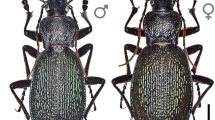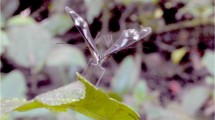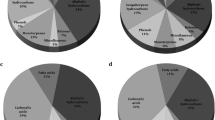Abstract
The anal secretions of 16 phlaeothripine thrips species (Thysanoptera: Phlaeothripidae) were studied, including a reinvestigation of three species previously reported. A total of 37 components were detected, including hydrocarbons, acetates, terpenes, carboxylic acids, a quinone, an aromatic compound, and a pyranone compound. The secretions of all species were composed of some of these components, with Xylaplothrips inquilinus possessing as many as 11 components. Of these components, (Z)-9-octadecene, (Z)-9-nonadecene, nonadecadiene, octanoic acid, decanoic acid, geranial, neral, α-pinene, β-pinene, caryophyllene, 2-hydroxy-6-methylbenzaldehyde, and two unidentified monoterpenes [UK-I (M+136) and UK-II (M+168)] were detected for the first time. The chemicals were species-specific; four Liothrips species and three Holothrips species could be distinguished from each other and their congeners by the GC profiles of the ether extracts of their anal secretions. The anal secretions of gall-inducing thrips commonly contained terpenes, of which citral (a mixture of geranial and neral) and β-acaridial repelled ants or had antifungal activity. The findings suggest that these terpenes play a defensive role and prevent galls from fungal infestation. 3-Butanoyl-4-hydroxy-6-methyl-2H-pyran-2-one, found from three Holothrips spp., caused paralysis in ants. Chemical analysis of anal secretion components is a useful method for the classification of tubuliferan species that are difficult to distinguish on the basis of morphological characters.
Similar content being viewed by others
REFERENCES
Ananthakrishnan, T. N. and Gopichandran, R. 1993. Chemical Ecology in Thrips-Host Plant Interactions. International Science Publisher, New York.
Blum, M. S. 1991. Chemical ecology of the Thysanoptera, pp. 95–108, in B. L. Parker, M. Skinner and T. Lewis (eds.). Towards Understanding Thysanoptera, Gen. Tech. Report NE-147, USDA, Forest Service, Northeastern For. Expt. Sta., Radar, PA.
Blum, M. S., Footitt, R., and Fales, H. M. 1992. Defensive chemistry and function of the anal exudate of the thrips Haplothrips leucanthemi. Comp. Biochem. Physiol. 102C:209–211.
Curtis, R. F., Hobson-Frohock, A., Fenwick, G. R., and Berreen, J. M. 1981. Volatile components from the mite Acarus siro L. in food. J. Stored Prod. Res. 17:197–203.
Francis, G. M. and Veland, K. 1981. Alkylthiolation for the determination of double-bond position in linear alkenes. J. Chromatogr. 219:379–384.
Haga, K., Suzuki, T., Kodama, S., and Kuwahara, Y. 1989. Secretion of thrips III. Secretion of acid-emitting thrips, Hoplothrips japonicus (Thysanoptera:Phlaeothripidae). Appl. Entomol. Zool. 24:242–244.
Haga, K., Suzuki, T., Kodama, S., and Kuwahara, Y. 1990. Secretion of thrips VI. Identification of β-myrcene from Thlibothrips isunoki (Thysanoptera: Phlaeothripidae). Appl. Entomol. Zool. 25:138–139.
Howard, D. F., Blum, M. S., and Fales, H. M. 1983. Defense in thrips: Forbidding fruitiness of a lactone. Science 220:335–336.
Howard, D. F., Blum, M. S., Jones, T. H., and Tomalski, M. D. 1987. Defense exudate of the Cuban laurel thrips Gynaikothrips ficorum (Marchal). Phytophaga 1:163–170.
Kuwahara, Y., Matsumoto, K., and Wada, Y. 1980. Pheromone study on acarid mites IV. Citral: Composition and function as an alarm pheromone and its secretory gland in four species of acarid mites. Jpn. J. Sanit. Zool. 31:73–80.
Kuwahara, Y., Leal, W. S., Suzuki, T., Maeda, M., and Masutani, T. 1989. Antifungal activity of Caloglyphus polyphyllae sex pheromone and other mite exudates. Naturwissenschaften 76:578–579.
Kuwahara, Y. 1999. Chemical ecology of acarid mites, pp. 380–393, in T. Hidaka, Y. Matsumoto, K. Honda, H. Honda, and T. Tatsuki. (eds.). Environmental Entomology. Behavior, Physiology and Chemical Ecology. University of Tokyo Press, Tokyo, Japan (in Japanese).
Leal, W. S., Kuwahara, Y., and Suzuki, T. 1989a. 2 (E)-(4-Methyl-3-pentenylidene)-butanedial, β-Acaridial: A new type of monoterpene from the mold mites Tyrophagus putrescentiae (Acarina, Acaridae). Agric. Biol. Chem. 53:875–878.
Leal, W. S., Kuwahara, Y., Suzuki, T., and Kurosa, K. 1989b. β-Acaridial, the sex pheromone of the acarid mite Caloglyphus polyphyllae. Naturwissenschaften 76:332–333.
Leal, W. S., Nakano, Y., Kuwahara, Y., Nakao, H., and Suzuki, T. 1988. Pheromone study on acarid mites XVII. Identification of 2-hydroxy-6-methyl-benzaldehyde as the alarm pheromone of the acarid mite Tyrophagus perniciosus (Acarina: Acaridae), and its distribution among related mites. Appl. Entomol. Zool. 23:422–427.
Mound, L. A. 1974. Spore-feeding thrips (Phlaeothripidae) from leaf litter and dead wood in Australia. Aust. J. Zool. 27 (Suppl.):1–106.
Mound, L. A. 1994. Thrips and gall induction: A search for patterns, pp. 131–149, in M. A. J. Williams (ed.). Plant Galls: Organisms, Interactions, Populations. Systematics Association Special Volume 49, Clarendon Press, Oxford, UK.
Mound, L. A. 1996. Thysanoptera, pp. 249–332, in A. Wells (ed.) Zoological Catalogue of Australia, Vol. 26. CSIRO Publishing, Melbourne, Australia.
Mound, L. A. 1997. Biological diversity, pp. 197–215, in T. Lewis (ed.). Thrips as Crop Pests. CAB International, Wallingford, UK.
Mound, L. A. and Marullo, R. 1996. The Thrips of Central and South America: An Introduction (Insecta: Thysanoptera). Associated Publishers, FL.
Mound, L. A. and Palmer, J. M. 1983. The generic and tribal classification of spore-feeding Thysanoptera (Phlaeothripidae: Idolothripinae). Bull. Br. Mus. (Nat. Hist.) Entomol. 46:1–174.
Mound, L. A., Wang, C.-L., and Okajima, S. 1996. Observations in Taiwan on the identity of the Cuban laurel thrips (Thysanoptera, Phlaeothripidae). J. N.Y. Entomol. Soc. 103:185–190.
Namiki, M., Nomoto, M., Yamamoto, K., and Shimose, R. 1952. Studies on the syntheses and antibiotic action of dehydroacyl acetic acid and dehydroacyl acetocarboxylic acid. Part 4-2. The relation between the elongation of alkyl radicals and their antibiotic activities. J. Agric. Chem. Soc. Jpn. 26:211–218 (in Japanese).
Okajima, S. 1979. A revisional study of the Apelaunothrips (Thysanoptera: Phlaeothripidae). Syst. Entomol. 4:39–64.
Okamoto, M., Matsumoto, K., Wada, Y., and Kuwahara, Y. 1981. Studies on antifungal effect of mite alarm pheromone citral 2. Anti-fungal effect of the hexane extracts of the grain mites and some analogues of citral. Jpn. J. Sanit. Zool. 32:265–270 (in Japanese with English summary).
Priesner, H. 1961. Das System der Tubulifera (Thysanoptera). Anzeiger der Österreichischen Akademie der Wissenschaften 1960:283–296.
Sakata, T., Hiramatsu, N., Ishikawa, K., and Kuwahara, Y. 1997. Chemical ecology of mesostigmatid mites. I. Identification of hydroxymethylnaphthoquinones from Uroactinia hirschmanni Hiramatsu (Mesostigmata: Uropodidae). Appl. Entomol. Zool. 32:57–61.
Suzuki, T., Haga, K., Izuno, M., Kodama, S., and Kuwahara, Y. 1993. Secretion of thrips VII. Identification of 3-butanoyl-4-hydroxy-6-methyl-2H-pyran-2-one from Holothrips japonicus and H. hagai (Thysanoptera: Phlaeothripidae). Appl. Entomol. Zool. 28:108–112.
Suzuki, T., Haga, K., Kataoka, M., Tsutsumi, T., Nakano, Y., Matsuyama, S., and Kuwahara, Y. 1995. Secretion of thrips VIII. Secretions of the two Ponticulothrips species (Thysanoptera: Phlaeothripidae). Appl. Entomol. Zool. 30:509–519.
Suzuki, T., Haga, K., Kodama, S., and Kuwahara, Y. 1988. Secretion of thrips II. Secretions of three gall-inhabiting thrips (Thysanoptera: Phlaeothripidae). Appl. Entomol. Zool. 23:291–297.
Suzuki, T., Haga, K., Kodama, S., and Kuwahara, Y. 1990. Secretion of thrips V. Secretion of idolothripine thrips, Bactrothrips brevitubus (Thysanoptera: Phlaeothripidae). Appl. Entomol. Zool. 25:1–7.
Suzuki, T., Haga, K., and Kuwahara, Y. 1986. Anal secretion of thrips I. Identification of perillene from Leewenia pasanii (Thysanoptera: Phlaeothripidae). Appl. Entomol. Zool. 21:461–466.
Suzuki, T., Haga, K., Leal, W. S., Kodama, S., and Kuwahara, Y. 1989. Secretions of thrips IV. Identification of β-acaridial from three gall-forming thrips (Thysanoptera: Phlaeothripidae). Appl. Entomol. Zool. 24:222–228.
Suzuki, T., Haga, K., Tsutsumi, T., and Matsuyama, S. 2000. Chemical analysis and comparison of acid components of anal secretions of idolothripine thrips. J. Chem. Ecol. 26:2449–2458.
Vincenti, M., Guglielmetii, G., Cassani, G., and Tonini, C. 1987. Determination of double bond positions in diunsaturated compounds by mass spectrometry of dimethyl disulfide derivatives. Anal. Chem. 59:694–699.
Author information
Authors and Affiliations
Rights and permissions
About this article
Cite this article
Suzuki, T., Haga, K., Tsutsumi, T. et al. Analysis of Anal Secretions from Phlaeothripine Thrips. J Chem Ecol 30, 409–423 (2004). https://doi.org/10.1023/B:JOEC.0000017985.89897.c3
Issue Date:
DOI: https://doi.org/10.1023/B:JOEC.0000017985.89897.c3




